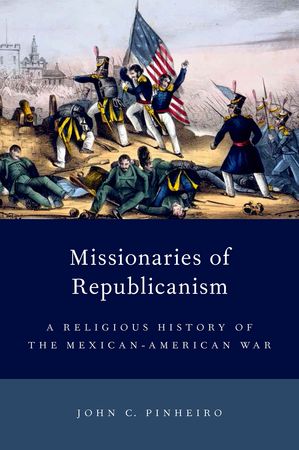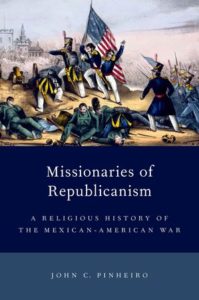The Role of Anti-Catholicism in the U.S.-Mexican War

Thirty years ago, Robert W. Johannsen published To The Halls of the Montezumas: The Mexican War in the American Imagination, inspiring historians to explore the impact that the conflict had on American society. Since then a number of books have examined how the U.S.-Mexican War influenced the domestic politics and culture of the United States. Adding to this growing body of work is John C. Pinheiro’s Missionaries of Republicanism: A Religious History of the Mexican-American War. This latest volume in Oxford’s much-touted “Religion in America” series draws from an impressive collection of antebellum sermons, pamphlets, broadsides, letters, and memoirs to bring to light the religious context of the United States’ 1846 invasion of its southern neighbor. Specifically, Pinheiro argues that the religious history of the U.S.-Mexican War shows “how anti-Catholicism emerged as integral to nineteenth-century American identity as a white, Anglo-Saxon, Protestant republic” (1). Indeed, animus toward Mexico’s state religion played a role in many aspects of the conflict, from the recruitment of soldiers to the drafting of the Treaty of Guadalupe Hidalgo.
Pinheiro introduces his study by highlighting the growing anti-papist fervor of the Second Great Awakening. Although a distrust of Catholicism existed before the framing of the nation, increasing immigration from Ireland and a growing fear of Vatican plots in northern Mexico during the 1830s converted a religious issue to a political one. In 1834, nativist Protestants burned the Ursuline Convent and School at Charlestown, Massachusetts, an event the author considers seminal to galvanizing anti-Catholic and anti-immigrant sentiment in the nation. Not coincidentally, this occurred as Yankee pioneers began to covet the Mexican provinces of Texas, Nuevo México, and Alta California. Pinheiro documents how this decade-long process influenced both United States’ society and politics.
As Americans looked westward for new territory, many viewed mixed-raced Mexicans and their Roman Catholic religion as inferior and incompatible with the Anglo-Saxon Protestant republicanism that was fated to sweep the continent. Firebrand ministers such as Lyman Beecher synthesized the ideas of white supremacy, anti-Catholicism, and Manifest Destiny into books, sermons, and pamphlets which shaped public perceptions of Mexico. Anti-Catholicism began as a domestic phenomenon, but its philosophies infiltrated the nation’s foreign policy following the presidential election of 1844. This contest was essentially a referendum on Manifest Destiny, with expansionist Democrats scoring a narrow victory, putting the United States on the path of war with Mexico.
After setting the stage for conflict, the book focuses on the ways in which anti-Catholic rhetoric was used to recruit volunteers to fight in Mexico. This was no easy task as immigrants born in Ireland and southern Germany composed a sizable minority of the standing army in 1846. President James K. Polk and his commanders Zachary Taylor and Winfield Scott also understood the danger of Mexico perceiving their campaigns as a religious war. To counter the appearance of a sectarian crusade, the president ordered Catholic chaplains to accompany the military into Mexico.
Later chapters examine how anti-Catholicism affected the waging of the war, from the goals of the political elite to the behavior of enlisted men and volunteers. As conflict came to the nation, Whigs, Democrats, nativists, and abolitionists all engaged with anti-Catholicism, often at their own peril. Democrats, in particular, had to balance their desire for national expansion with their growing Catholic electoral base. This continued to be a difficult feat as American troops pushed farther into Mexican territory in 1847. Pinheiro notes that “American politicians recognized that only through some combination of anti-Catholic sentiment, racism, and republican principles could they maintain a nationally coherent stand on the war” (107). He finishes his study with an analysis of how such sentiment shaped congressional debates over the Treaty of Guadalupe Hidalgo and how this bigotry gave rise to the short-lived but influential Know Nothing Party of the 1850s.
Pinheiro’s research is exhaustive and his writing clear. As the director of the Catholic Studies Program at Aquinas College and a noted scholar of the early American republic, he is firmly in his element. Among his most interesting discoveries is the relationship between race and religion during the 1840s. While there has been significant work done in the role of race in the United States’ decision to invade and annex northern Mexico, Pinheiro adds to this by demonstrating the ways in which many Americans conflated race and religion in forming their opinions of Mexico. Drawing from an interesting diversity of sources, the author highlights the anti-Catholic rhetoric that droned in the background of the national dialogue about Manifest Destiny.
Pinheiro focuses on many instances of religious bigotry, but he is careful not to paint the nation with too broad a brush. While giving numerous examples of the bigoted views and actions of individual soldiers, for example, he does not ascribe anti-Catholic motivation to all servicemen. In fact, he cites several instances of Catholic officers and enlisted men fighting in Mexico with as much vigor as their Protestant counterparts. This is in keeping with Tyler V. Johnson’s complementary Devotion to the Adopted Country: U.S. Immigrant Volunteers in the Mexican War, which showed how many Catholic soldiers saw the war as a way to prove their patriotism and allegiance to the United States.
Although its subtitle hints at a more comprehensive work, Missionaries of Republicanism: A Religious History of the Mexican-American War is largely focused on pervasive anti-Catholicism in the United States. There are enticing mentions of Catholic counterstrategies, denominational schisms over slavery, violence against Mormons, and Catholic reactions in Mexico, but this book is primarily concerned with evangelical Protestants in the lead-up to and execution of war. This is not to say that Pinheiro’s study is in any way deficient. He proves his thesis by clearly linking the development of American identity during the U.S.-Mexican War to the era’s marked opposition to the Catholic Church. Even so, promise remains for other perspectives in the complex religious history of this oft-overlooked war, and Pinheiro is to be commended for opening the door to this future research.
This article originally appeared in issue 15.3 (Spring, 2015).
Michael Scott Van Wagenen is an associate professor and public history coordinator at Georgia Southern University. He is the author of The Texas Republic and the Mormon Kingdom of God (2002) and Remembering the Forgotten War: The Enduring Legacies of the U.S.-Mexican War (2012).
